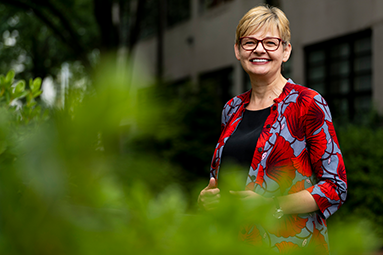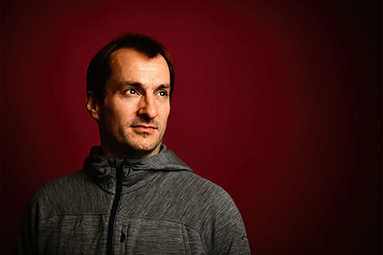Newly Founded Plastics Center Strives for Innovative Solutions to Plastic Waste

MES/COS/CEE Professor Aron Stubbins will co-direct the new Plastics Center at Northeastern University. The center’s goal is to bring together plastic researchers and expand knowledge about plastics and public policy.
This article originally appeared on Northeastern Global News. It was published by Alena Kuzub. Main photo: Plastics have been found in human brains, lungs, digestive system—even in babies—but there is still a lack of data on what harm they cause. Photo by Alyssa Stone/Northeastern University
New plastics center at Northeastern aims to tackle pollution, policy, and innovation
Maria Ivanova and Aron Stubbins will co-direct the new Plastics Center at Northeastern University, a hub dedicated to exploring the complex challenges surrounding plastics use, waste, and regulation.
Ivanova, director of the School of Public Policy and Urban Affairs, says the center’s mission is threefold. First, to bring together Northeastern researchers working on plastics. Second, to expand the knowledge about plastics and public policy at every stage of their life cycle.
“And number three is to actually make a difference in the negotiations in the policy process,” she says.
The center’s broad goal is to understand the so-called plastics dilemma, says Stubbins, professor of marine and environmental sciences, chemistry and chemical biology, and civil and environmental engineering at Northeastern.
 |
 |
Maria Ivanova, left, director of Northeastern’s School of Public Policy and Urban Affairs, and Aron Stubbins, professor of marine and environmental sciences, chemistry and chemical biology, and civil and environmental engineering at Northeastern. Photo by Alyssa Stone/Northeastern University and Adam Glanzman/Northeastern University
Originally invented to replace natural ivory, plastics not only helped elephant conservation but also lowered the cost of many goods. They continue to offer significant benefits: plastic packaging makes food last longer, Stubbins says; polymer varnishes make wood more durable; and lighter plastic parts make airplanes much lighter, reducing fuel consumption.
“What would hospitals look like without gloves, syringes, tubing?” Stubbins says. “It’s just almost unimaginable.”
But plastics also come with serious downsides, Stubbins says, such as growing long-lasting waste and the potential leaching of toxins into food and water that harm both humans and the environment.
“The broad issue is to understand that balance [between the good and the bad] and try to use plastics in ways that minimize the human health and the environmental impacts,” Stubbins says.
While plastics have been detected in human brains, lungs, and digestive systems—even in babies—there is still a lack of data on what harm they cause, he says, and how to mitigate it.
He emphasizes the need for systemic change to improve plastics safety and reduce carbon dioxide emissions associated with plastics.
“A lot of the time, we don’t have the choice to use plastics that are safer because the market supplies us with toxic things and we don’t have a choice to buy non-toxic things,” Stubbins says. “We need the policy to put that into place … to create societal pressure [on manufacturers].”
By identifying toxic additives and promoting safer alternatives, both scientific knowledge and regulations can lead to meaningful change.
Several years ago, Stubbins began conversations with his Northeastern colleagues— including chemists, material engineers, and human health experts—to see who was focusing their research on different aspects of plastics. They held a series of workshops discussing possible collaborations.
Read full story at Northeastern Global News